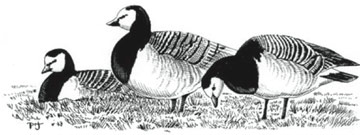Barnacle Goose (Branta leucopsis)

Barnacle Geese © Phil Jones
More than one hundred years ago, wild Barnacle Geese used to winter on the Dee estuary, but now the only birds seen are likely to have originated from wildfowl collections. There seems just an outside possibility that the single mapped bird at the coast could have been wild.
There are three isolated populations of Barnacle Geese, breeding in Greenland, Svalbard and western Siberia, with no interchange between them. The first two winter exclusively in the British Isles, Greenland birds on the western seaboard of Scotland and Ireland, and the Svalbard flock on the Solway Firth. The Siberian breeders winter in the Netherlands.
In the 19th century, the winter distribution of Barnacle Geese was obviously very different. Brockholes (1874) stated that ‘prior to 1862, this species was very common on the Dee Marshes, now it is very scarce; sometimes a whole winter passes without any being seen’; and Coward (1910) wrote that ‘Barnacles deserted the locality when the marshes carried so many sheep’. Eight near Hilbre on 2 March 1886, and one shot near Burton Marsh 29 September 1901 were worthy of comment. There were also considerable numbers on Morecambe Bay as late as 1879, and it was plentiful on the Ribble marshes as recently as 1909 (Oakes 1953).
The retreat of the wild stock almost coincided with the start of records of birds considered to be feral; Barnacle Goose appears to be one of the species most likely to have escaped from, or been released from, wildfowl collections. Bell (1962) notes odd birds in 1911, 1912, 1921/ 22, 1947, 1961 and 1962 at Radnor Mere and Tabley, but birds off Hilbre might have more authentic pedigrees: three on 3 April 1940 and singles on 5 & 6 December 1942 and 31 December 1961. Since then, the annual county bird reports have included birds in the body of the report rather than the ‘escapes’ section, but often with comments about their likely provenance. Given that wild Barnacle Geese are gregarious, almost exclusively coastal and amongst the most nervous of all wildfowl, the status of birds inland in Cheshire, many of them associating with Canada or Greylag Geese, can easily be guessed at. They should, nevertheless, be comprehensively recorded: what if they became the Canada Goose of the future?
However, as with the changes in the 19th century, we should note that modern wildfowl populations are proving to be quite adaptable in their habits, especially as population figures are so high and likely to be putting pressure on resources at their traditional sites. In recent years, a wintering flock of Barnacle Geese has become established at the Dyfi Estuary in mid-Wales, with 140 birds there in 2004/ 05. They associate with Greenland White-fronted Geese and it is assumed that these Barnacle Geese are from the Greenland breeding population rather than the Svalbard one. Also, the Svalbard birds seem mostly to keep to one large group while the Greenland birds are more prone to forming smaller, scattered, flocks. It seems possible that birds from the Dyfi flock could be found in our area, and perhaps the occasional coastal record derives from this population. Birdwatchers should keep a careful eye open for any colour-marked birds, or even try to collect a cast-off feather: with scientific analysis in its advanced state, it could be possible to prove their origin, rather than merely speculate!
Traditionally, Barnacle Geese have fed on saltmarshes and coastal pastures, but more recently their requirement for short-cropped sward has been met by intensively managed grasslands. They eat grasses, herbs, leaves, stolons and seeds, as well as barley and oat stubbles, spilt grain and undersown grass.
WeBS counts attempt to come up with estimates for the naturalised population of Barnacle Geese in Britain, with recent figures of almost 1,000 birds (Musgrove et al 2007). The Cheshire and Wirral figure might be in the range 10-20 birds.Sponsored by Brian Grieve

